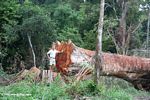
Selective logging in Brazil. Photo by Luke Parry.
Selective logging and small sub-canopy fires are degrading vast areas of rainforest across the Brazilian Amazon, contributing to largely hidden carbon emissions, argues a study published today in Global Change Biology.
The research, published by ten researchers from 11 institutions, is based on field data from some 87,000 plant and soil samples across 225 sites covering three million hectares in Santarém and Paragominas in the state of Pará, which accounts for the bulk of timber production in the Brazilian Amazon. It found stark differences in carbon storage between primary forests, selectively logged forests, logged and burned forests, and regrowing or secondary forests.

The study confirmed that selective logging is playing a key role in diminishing carbon stocks across the world’s largest rainforest. Logging both removes carbon-dense trees from the landscape and leaves surviving areas more vulnerable to edge effects and drying, heightening the risk of fires that further degrade the forest. Ultimately logging and fire can dramatically alter a forest, transitioning it away from the cathedral-like structure of a typical rainforest toward dry scrub dominated by vines and lianas.

Left: Undisturbed forest in the Amazon. Photo by Malva Hernandez. Right: Logged-and-burned forest in the Amazon. Photo by Erika Berenguer
Given the scale of logging operations in Brazil, the study indicates that timber harvesting in the Amazon is a significant source of carbon loss.
“We found that selective logging and ground fires in the Brazilian Amazon account for an additional 540 million metric tons of carbon being annually lost in the region, nearly half of the annual carbon loss from deforestation,” lead author Erika Berenguer of Lancaster University told mongabay.com. “The impacts of logging and wildfires, and the resultant carbon loss, have been grossly underestimated and overlooked to date by the Brazilian government.”
 Understory fire. Photo by Jos Barlow |
The findings emphasize the importance of accounting for logging and fire in initiatives that aim to slow climate change, like the Reducing Emissions from Deforestation and forest Degradation (REDD+) program, says Berenguer.
“Forest degradation needs to be incorporated in the designing phase of REDD+ projects by mapping out the risks of human-driven disturbance a project might face, together with mechanisms to avoid the onset of such disturbances,” she said. “In addition, REDD+ projects need to ensure they carry out periodic, reliable and replicable monitoring of forest degradation, just as it is done with deforestation. At the moment, this hasn’t been widely seen in the Amazon.”
In Brazil, monitoring of forest degradation is primarily conducted by Imazon, a Brazilian NGO, which releases a monthly report based on satellite data analysis. Imazon’s report estimates total deforestation and degradation across the Amazon, along with associated emissions. Outside of Brazil, but still in the Amazon, agencies in Colombia and Peru use a system called CLASlite for monitoring degradation.

Amazon logs. While there are a wide range of REDD+ projects, some of the more controversial involve selective logging based on the premise that less damaging forms of timber extraction represent a net savings of emissions relative to conventional logging. But a recent study in Indonesia found that in practice, reduced impact logging may not actually cut emissions, lending support to the argument that subsidies for logging in primary forests may not be an effective use of REDD+ funds. Photo by co-author Jos Barlow
The researchers note that while monitoring platforms are constantly improving, on-the-ground field work is still important.
“Ground surveys of disturbance signals are therefore invaluable tools for providing basic information on the past disturbance regime in a given area of forest and can help decision makers to evaluate areas more likely to maintain carbon stocks in the long term,” they write, adding that boosting protection of old-growth forests should be a conservation priority.
“Investments in avoiding further disturbance (e.g. fire breaks) in low-disturbed forests can avoid structural shifts and ensure permanence of carbon in human-modified forests, hence constituting a great conservation opportunity,” they write. “The continuous neglect of the widespread impacts of forest degradation will result in additional, and unaccounted, greenhouse gases emissions from tropical countries, with consequent impacts on the world’s climate.”
CITATION: Erika Berenguer, Joice Ferreira, Toby Alan Gardner, Luiz Eduardo Oliveira Cruz Aragão, Plínio Barbosa de Camargo, Carlos Eduardo Cerri, Mariana Durigan, Raimundo Cosme de Oliveira Junior, Ima Célia Guimarães Vieira, Jos Barlow. A Large-Scale Field Assessment of Carbon Stocks in Human-Modified Tropical Forests. Global Change Biology. Article first published online: 27 MAY 2014. DOI: 10.1111/gcb.12627
Related articles
Emissions from rainforest logging average 16% of those from deforestation
(04/08/2014) Carbon emissions from selective logging operations in tropical rainforests are roughly a sixth of those from outright forest clearing, finds a new study that evaluated 13 forestry concessions in six countries. The study analyzed carbon losses from elements of logging operations, including timber extraction, collateral damage to surrounding vegetation, and logging infrastructure like roads and skid trails.
Reduced impact logging failing to cut emissions in Indonesia
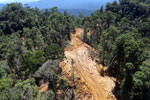
(02/10/2014) Advocates for reduced impact logging in tropical forests often make a case that better forest management cuts carbon emissions relative to traditional forms of timber harvesting. While the argument for altering logging approaches to limit forest damage makes intuitive sense, a new study suggests that the carbon benefits may not bear out in practice.
Next big idea in forest conservation? Incentivizing keeping primary forests intact

(02/07/2014) Much of Dr. Corey Bradshaw’s work has a singular aim: to keep primary habitats and functioning ecosystems intact. According to Bradshaw, the existing system of carbon trading rules needs to be changed so that primary forests are given a higher value than other forms of land use. ‘Nothing, can replace primary vegetation, both in terms of biodiversity value and other ecosystem services.’
Old-growth trees store half rainforest carbon

(08/07/2013) Large trees store store up to half the above-ground biomass in tropical forests, reiterating their importance in buffering against climate change, finds a study published in Global Ecology and Biogeography. The research, which involved dozens of scientists from more than 40 institutions, is based on data from nearly 200,000 individual trees across 120 lowland rainforest sites in Africa, Asia, and Latin America. It found that carbon storage by big trees varies across tropical forest regions, but is substantial in all forests.
Global decline of big trees in old-growth forests worrying, argue scientists
(12/06/2012) The decline of large trees is putting biodiversity and forest health at risk globally, warn researchers writing in the journal Science.
Experts: sustainable logging in rainforests impossible
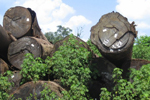
(07/19/2012) Industrial logging in primary tropical forests that is both sustainable and profitable is impossible, argues a new study in Bioscience, which finds that the ecology of tropical hardwoods makes logging with truly sustainable practices not only impractical, but completely unprofitable. Given this, the researchers recommend industrial logging subsidies be dropped from the UN’s Reducing Emissions from Deforestation and Forest Degradation (REDD+) program. The study, which adds to the growing debate about the role of logging in tropical forests, counters recent research making the case that well-managed logging in old-growth rainforests could provide a “middle way” between conservation and outright conversion of forests to monocultures or pasture.
Big trees, like the old-growth forests they inhabit, are declining globally
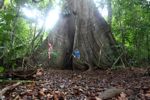
(01/26/2012) Already on the decline worldwide, big trees face a dire future due to habitat fragmentation, selective harvesting by loggers, exotic invaders, and the effects of climate change, warns an article published this week in New Scientist magazine. Reviewing research from forests around the world, William F. Laurance, an ecologist at James Cook University in Cairns, Australia, provides evidence of decline among the world’s ‘biggest and most magnificent’ trees and details the range of threats they face. He says their demise will have substantial impacts on biodiversity and forest ecology, while worsening climate change.
Logging of primary rainforests not ecologically sustainable, argue scientists
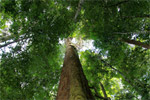
(01/25/2012) Tropical countries may face a risk of ‘peak timber’ as continued logging of rainforests exceeds the capacity of forests to regenerate timber stocks and substantially increases the risk of outright clearing for agricultural and industrial plantations, argues a trio of scientists writing in the journal Biological Conservation. The implications for climate, biodiversity, and local economies are substantial.
